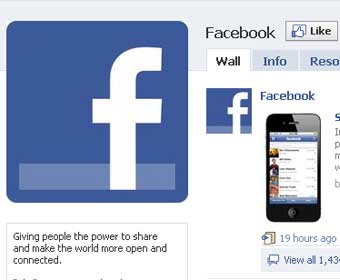Facebook files a big IPO, but it also has a potentially big problem
Social network Facebook has finally filed an S-1 registration document for its initial public offering (IPO) with the US Securities and Exchange Commission (SEC). In the S-1, Facebook states that it aims to raise $5bn when it lists on either the Nasdaq or the NYSE in May, which some estimates suggest could value the company at around $100bn. That’s not the only big number that Facebook reveals in the S-1.
February 10, 2012

By Pamela Clark-Dickson
Social network Facebook has finally filed an S-1 registration document for its initial public offering (IPO) with the US Securities and Exchange Commission (SEC). In the S-1, Facebook states that it aims to raise $5bn when it lists on either the Nasdaq or the NYSE in May, which some estimates suggest could value the company at around $100bn.
That’s not the only big number that Facebook reveals in the S-1, however:
US$3.7 billion in revenues in 2011 (up from US$1.97 billion in 2010)
Advertising sales contributes 85 per cent of revenues
845 million monthly active users
483 million daily active users on average in December 2011
360 million users active on six days out of seven in December 2011
425 million mobile monthly active users
250 million photos uploaded daily
2.7 billion likes and comments per day
100 billion friend connections at end-December 2011
As you would expect, there’s an incredible amount of detail about Facebook and its business in the S-1, and chairman and CEO Mark Zuckerberg’s letter also provides a fascinating insight into the Facebook culture. Overall, the document makes for interesting reading.
But, taking a closer look at mobile, the S-1 reveals that mobile Facebook users are growing faster than overall Facebook users. The company expects that this will continue to be the case “for the foreseeable future”, as it continues to focus on facilitating the use of Facebook on mobile devices.
Facebook’s mobile strategy is multi-faceted, consisting of enabling its users to interact with it via USSD, SMS, MMS, mobile Internet or a free downloadable application. In a lot of cases, the interaction is also free, or at the very least it is included in the mobile subscriber’s existing messaging or data plan.
But Facebook is incurring some costs in order to provide the mobile interaction. For example, if a Facebook user opts to have SMS alerts sent to their mobile device, Facebook pays a messaging supplier (an operator or a messaging aggregator) to send those messages, meaning that the social network incurs additional costs for enabling this capability.
Also, in a number of emerging markets, Facebook has made agreements with mobile operators to enable its Facebook Zero zero-rated mobile data service, which means that the data traffic associated with mobile subscribers’ use of Facebook is free. Again, it is possible that the social network is incurring the costs of the zero-rated mobile data traffic, on the other hand, Facebook may have agreed with the mobile operator that these costs are ‘written off’, because the operator may view enabling access to Facebook on its network as a customer acquisition tool.
The ‘freemium’ business model has been staggeringly successful for Facebook as a customer acquisition tool: it now has 425 million mobile monthly active users, comprising 50.3 per cent of its total user base. It is also likely that a proportion of these mobile MAUs are desktop MAUs as well, particularly in developed markets where Facebook users can access the social network via both the desktop- and mobile Internet. But the S-1 doesn’t indicate what proportion of mobile MAUs are mobile-only MAUs and what proportion are desktop-and-mobile MAUs.
Regardless, the social network is not currently generating meaningful revenues from its mobile users, according to the S-1, and furthermore, its “ability to do so successfully remains unproven”. Clearly, lack of revenues from mobile is not an immediate problem for Facebook, given that it is generating substantial revenue from PC-based display advertising. However, lack of revenues from mobile will become a significant problem in the future if, or more likely, when mobile-only MAUs comprise the bulk of its user base.
Facebook did allude to one potential source of revenues from mobile in its S-1: the insertion of sponsored stories into mobile users’ News Feeds (sponsored stories are either posted by brands and advertisers, or shared by brands and advertisers, with Facebook users who ‘like’ their pages). Otherwise, there is very little detail about how the social network plans to make money from its mobile user base. One possibility is that Facebook could sell mobile advertising (as well as sponsored stories); alternatively, it could enable in-app payments on mobile via its Payments platform.
Meanwhile, a paucity of revenues is not the only problem Facebook is facing in mobile: the company also admits that it is “dependent on the interoperability of Facebook with popular mobile operating systems that we do not control, such as Android and iOS.” It is possible that OS-makers and device manufacturers could make changes to their platforms that could negatively impact on the running of Facebook on their platforms, according to the S-1; alternatively they could give preferential treatment to a Facebook competitor. According to Facebook, its social networking competitors include Google+ and, at a regional level, Korea’s Cyworld, Mixi in Japan, the Google-owned Orkut in Brazil and India, and Renren, Sina and Tencent in China.
Read more about:
DiscussionYou May Also Like






.png?width=300&auto=webp&quality=80&disable=upscale)


_1.jpg?width=300&auto=webp&quality=80&disable=upscale)


.png?width=800&auto=webp&quality=80&disable=upscale)